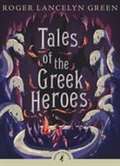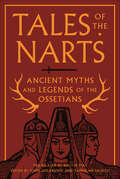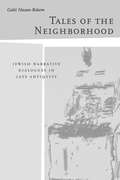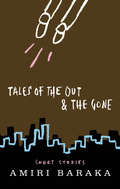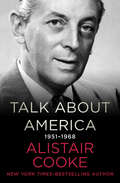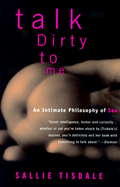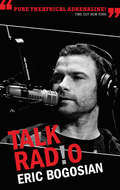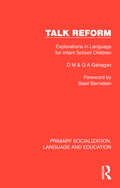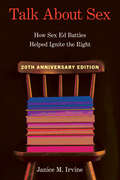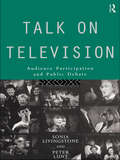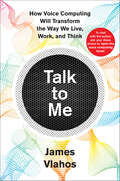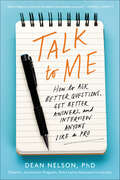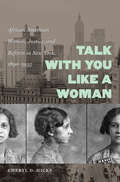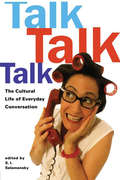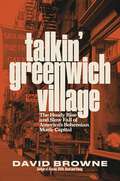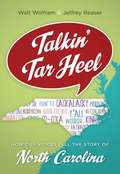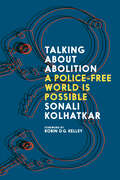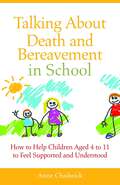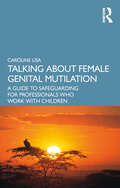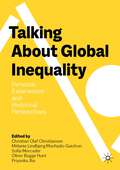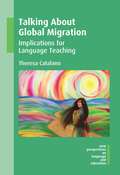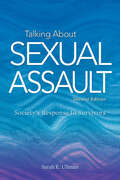- Table View
- List View
Tales of the Greek Heroes
by Roger Lancelyn GreenSome of the oldest and most famous stories in the world -- the adventures of Perseus, the labors of Heracles, the voyage of Jason and the Argonauts -- are vividly retold in this single, connected narrative of the Heroic Age, from the coming of the Immortals to the first fall of Troy. With fresh dialogue and a brisk pace, the myths of this version are enthrallingly vivid.
Tales of the Narts: Ancient Myths and Legends of the Ossetians
by John Colarusso ; Tamirlan SalbievThe Nart sagas are to the Caucasus what Greek mythology is to Western civilization. Tales of the Narts presents a wide selection of fascinating tales preserved as a living tradition among the peoples of Ossetia in southern Russia, a region where ethnic identities have been maintained for thousands of years in the face of major cultural upheavals.A mythical tribe of tall, nomad warriors, the Narts were courageous, bold, and good-hearted. But they were also capable of cruelty, envy, and forceful measures to settle disputes. In this wonderfully vivid and accessible compilation of stories, colorful and exciting heroes, heroines, villains, and monsters pursue their destinies though a series of peculiar exploits, often with the intervention of ancient gods.The world of the Narts can be as familiar as it is alien, and the tales contain local themes as well as echoes of influence from diverse lands. The ancestors of the Ossetians once roamed freely from eastern Europe to western China, and their myths exhibit striking parallels with ancient Indian, Norse, and Greek myth. The Nart sagas may also have formed a crucial component of the Arthurian cycle.Tales of the Narts further expands the canon of this precious body of lore and demonstrates the passion and values that shaped the lives of the ancient Ossetians.
Tales of the Neighborhood: Jewish Narrative Dialogues in Late Antiquity
by Galit Hasan-RokemHasan-Rokem explores the relationship between literature and 'reality' in Late Antique Jewish culture by way of sacred Rabbinic stories from the Talmud and the Midrash, focusing on specific Hebrew and Aramaic narratives dating between 150 and 500 CE.
Tales of the Out & the Gone: Short Stories
by Amiri BarakaComprising short fiction from the early 1970s to the twenty-first century—most of which has never been published—Tales of the Out & the Gone reflects the astounding evolution of America’s most provocative literary anti-hero. <p><p> The first section of the book, “War Stories,” offers six stories enmeshed in the vola-tile politics of the 1970s and 1980s. The second section, “Tales of the Out & the Gone,” reveals Amiri Baraka’s increasing literary adventurousness, combining an unpredictable language play with a passion for abstraction and psychological exploration. <p> Throughout, Baraka’s unique and constantly changing literary style will educate readers on the evolution of one of America’s most accomplished literary masters of the past four decades.
Talk About America, 1951–1968: Letters From America, Talk About America, And The Americans
by Alistair Cooke&“There is never going to be anyone else like Cooke, a chronicler of amazing times.&” —The Daily Telegraph As the voice of the BBC&’s Letter from America for close to six decades, Alistair Cooke addressed several millions of listeners on five continents. They tuned in every Friday evening or Sunday morning to listen to his erudite and entertaining reports on life in the United States. According to Lord Hill of Luton, chairman of the BBC, Cooke had &“a virtuosity approaching genius in talking about America in human terms.&” This second collection of Cooke&’s personally selected letters covers tumultuous events in American history such as the Vietnam War and the civil rights movement. His analysis of the origins of the conflict in Vietnam is clear eyed and compelling, and in three thoughtful and incisive essays—on Brown v. Board of Education, the struggle to integrate the Deep South, and the riots in Watts—Cooke identifies the changing racial attitudes that defined the era. He reflects on the rise of drug use among college students and offers a paean to the beauty of Golden Gate Park. With characteristically incisive portraits of political and cultural figures such as John F. Kennedy, Lyndon Johnson, Robert Frost, H. L. Mencken, Charles Lindbergh, and John Glenn, Talk About America: 1951–1968 is rich with humor, compassion, and commitment. In this superb overview of an astonishing era in America&’s twentieth century, Alistair Cooke is at the top of his game.
Talk Dirty to Me
by Sallie TisdaleWe live in a world in which almost every public image--every interaction--carries an element of sexual desire. And yet it is nearly impossible for us to talk openly and honestly about sex. Talk Dirty to Me is author Sallie Tisdale's frank, funny, and provocative invitation to the conversation we've been waiting for--but have been too afraid to start.Sallie Tisdale shuns the dry style of academics and takes us on a journey through gender and desire, romance and pornography, prostitution and morality, fantasies and orgasm. She guides us through her field research of peep shows, XXX stores, and even the pornography collection of the British Library. Interweaving her own personal feelings, experiences, and revelations, she presents a brilliant, fascinating, and wholly original portrait of sex and sexuality in America, while encouraging us to explore and create our own "intimate philosophies."From the Trade Paperback edition.
Talk Radio (TCG Edition)
by Eric Bogosian"Your fear, your own lives, have become your entertainment."--Talk Radio"More timely today than it was twenty years ago . . . Radio crackles with intensity."--Joe Dziemianowicz, New York Daily News"The most lacerating portrait of a human meltdown this side of a Francis Bacon painting. . . . This revival, like the original production, allows its star to grab an audience by the lapels and shake it into submission."--Ben Brantley, The New York TimesEric Bogosian's Talk Radio--his breakthrough 1987 Public Theater hit that was made into a film by Oliver Stone--has been revived in a "mesmerizing" (Newsday) production on Broadway, with Liev Schreiber playing the role of the late-night shock jock that Bogosian himself originated. The drama is set in the studio of Cleveland's WTLK Radio over the course of Barry Champlain's two-hour broadcast, being scrutinized that night by producers with an interest in taking the show national, and fueled as always by coffee, cocaine, and Jack Daniel's. Barry's jousts with his unseen callers--ranging from a white supremacist to a woman obsessed with her garbage disposal--are peppered with insights into his character from his ex-deejay pal and his sometime girlfriend/producer, and punctuated with a transformative visit from an embodied voice. Eric Bogosian is a writer and actor who over the last twenty years has authored five full-length plays and created six full-length solos for himself, including subUrbia; Sex, Drugs, Rock & Roll; Pounding Nails in the Floor with My Forehead;and Drinking in America. He is the recipient of three OBIE Awards and a Drama Desk Award, and has toured throughout the United States and Europe.
Talk Reform: Explorations in Language for Infant School Children (Primary Socialization, Language and Education)
by D. M. Gahagan G. A. GahaganOriginally published in 1970, Talk Reform describes the development of an exploratory language enrichment programme devised by the authors and carried out by teachers in a group of primary schools in a working-class area of London.Inspired by Bernstein’s theory of different language codes and their relation to educational underachievement, the authors devised a series of situations in the classroom as preconditions for extending language use. Their aim was to reorient the reader to the social functions of language, so that teachers who understood the ideas behind this programme would be able to carry out the activities described as well as those they may have thought up for themselves. The kinds of problems encountered when trying to judge the value of intervention and change in the classroom are discussed and illustrated, from the authors’ own research. The authors put forward the view that the social and linguistic skills that could be acquired in the way outlined in their book were crucial to the advancement of the working-class child in the social system. Today it can be read in its historical context.
Talk about Sex: How Sex Ed Battles Helped Ignite the Right (Sexuality Studies)
by Janice IrvinePraise for Talk about Sex “Must reading for scholars, sexuality researchers, activists, and public policy and public health planners engaged in efforts to promote education on sex, sexually transmitted diseases, and HIV infection prevention for adolescents in schools.”—JAMA Talk about Sex is a rich social history about the political transformations, cultural dynamics, and emotional rhetorical strategies that helped the right wing manufacture controversies on the local and national levels in the United States. Although the emergence of a politicized Christian Right is commonly dated at the mid-seventies, with the founding of groups like the Moral Majority, Talk about Sex tells the story of a powerful right-wing Christian presence in politics a full decade earlier. These activists used inflammatory sexual rhetoric—oftentimes deceptive and provocative—to capture the terms of public debate, galvanize voters, and reshape the culture according to their own vision. This 20th Anniversary Edition includes a new preface and epilogue by the author that examines current controversies over public education on sexuality, gender, and race. Demonstrating how the right wing draws on the cultural power of sexual shame and fear to build a political movement, Talk about Sex explores the complex entanglements of sexual knowledge, politics, and discourses.
Talk about Sex: How Sex Ed Battles Helped Ignite the Right (Sexuality Studies)
by Janice IrvinePraise for Talk about Sex “Must reading for scholars, sexuality researchers, activists, and public policy and public health planners engaged in efforts to promote education on sex, sexually transmitted diseases, and HIV infection prevention for adolescents in schools.”—JAMA Talk about Sex is a rich social history about the political transformations, cultural dynamics, and emotional rhetorical strategies that helped the right wing manufacture controversies on the local and national levels in the United States. Although the emergence of a politicized Christian Right is commonly dated at the mid-seventies, with the founding of groups like the Moral Majority, Talk about Sex tells the story of a powerful right-wing Christian presence in politics a full decade earlier. These activists used inflammatory sexual rhetoric—oftentimes deceptive and provocative—to capture the terms of public debate, galvanize voters, and reshape the culture according to their own vision. This 20th Anniversary Edition includes a new preface and epilogue by the author that examines current controversies over public education on sexuality, gender, and race. Demonstrating how the right wing draws on the cultural power of sexual shame and fear to build a political movement, Talk about Sex explores the complex entanglements of sexual knowledge, politics, and discourses.
Talk on Television: Audience Participation and Public Debate (Communication and Society)
by Sonia Livingstone Peter LuntNot only is everyday conversation increasingly dependent on television, but more and more people are appearing on television to discuss social and personal issues. Is any public good served by these programmes or are they simply trashy entertainment which fills the schedules cheaply? Talk on Television examines the value and significance of televised public debate. Analysing a wide range of programmes including Kilroy, Donohue and The Oprah Winfrey Show, the authors draw on interviews with both the studio participants and with those watching at home. They ask how the media manage discussion programmes and whether the programmes really are providing new 'spaces' for public participators. They find out how audiences interpret the programmes when they appear on the screen themselves, and they unravel the conventions - debate, romance, therapy - which make up the genre. They also consider TV's function as a medium of education and information, finally discussing the dangers and opportunities the genre holds for audience participation and public debate in the future.
Talk to Me: How Voice Computing Will Transform the Way We Live, Work, and Think
by James Vlahos**To chat with the author, ask your Alexa device to "open the voice computing book."** The next great technological disruption is coming The titans of Silicon Valley are racing to build the last, best computer that the world will ever need. They know that whoever successfully creates it will revolutionize our relationship with technology—and make billions of dollars in the process. They call it conversational AI. Computers that can speak and think like humans may seem like the stuff of science fiction, but they are rapidly moving toward reality. In Talk to Me, veteran tech journalist James Vlahos meets the researchers at Amazon, Google, and Apple who are leading the way. He explores how voice tech will transform every sector of society: handing untold new powers to businesses, overturning traditional notions of privacy, upending how we access information, and fundamentally altering the way we understand human consciousness. And he even tries to understand the significance of the voice-computing revolution first-hand — by building a chatbot version of his terminally ill father. Vlahos&’s research leads him to one fundamental question: What happens when our computers become as articulate, compassionate, and creative as we are?
Talk to Me: How to Ask Better Questions, Get Better Answers, and Interview Anyone Like a Pro
by Dean Nelson“The perfect guide to interviewing . . . anyone who speaks with fellow humans to acquire information will find Nelson’s guidance priceless.” —Tom Foster, New York Times–bestselling author of How to Read Literature Like a ProfessorInterviewing is the single most important way journalists (and doctors, lawyers, social workers, teachers, human resources staff, and, really, all of us) get information. Yet to many, the perfect interview feels more like luck than skill—a rare confluence of rapport, topic, and timing. But the thing is, great interviews aren’t the result of serendipity and intuition, but rather the result of careful planning and good journalistic habits. And Dean Nelson is here to show you how to nail the perfect interview every time. Drawing on forty-years of award-winning journalism and his experience as the founder and host of the Writer’s Symposium by the Sea, Nelson walks you through each step of the journey from deciding whom to interview and structuring questions, to the nitty gritty of how to use a recording device and effective note-taking strategies, to the ethical dilemmas of interviewing people you love (and loathe). He also includes case studies of famous interviews to show how these principles play out in real time. Chock full of comprehensive, time-tested, gold-standard advice, Talk to Me is a book that demystifies the art and science of interviewing. “One of the best interviewers around.” —Anne Lamott, New York Times–bestselling author of Help, Thanks, Wow
Talk to Your Boys: 16 Conversations to Help Tweens and Teens Grow into Confident, Caring Young Men
by Joanna Schroeder Christopher PepperAn urgent and practical book that helps parents and their boys navigate important topics like sex, drugs, bullying, power, consent, and more in a way that helps them grow their emotional intelligence, while also building connection and a closeness that can last a lifetime.Talk to your Boys is a practical guide to communicating with your tween and teen boy with the goal of raising young men who care about themselves and others. The book focuses on 16 essential and wide‑ranging conversations on mental health and masculinity, sex and consent, money and power, violence and guns, and more. Packed with helpful advice, conversation starters, tips and scripts, Talk to Your Boys is designed to help families get better at having these crucial, but sometimes awkward, discussions with the larger goal to raise emotionally intelligent men who aren't hemmed in by outdated ideas of masculinity. Co‑authors Joanna Schroeder, a parenting journalist, and Christopher Pepper, an award‑winning educator, have a real understanding of how challenging it is to navigate the ever‑changing worlds of teenagers with compassion and wisdom—especially when one has multiple children at different stages of development. Their practical advice is woven together with interviews with the leading experts in psychology, gender issues, and child development along with the voices and perspectives from dozens of teen boys from different backgrounds.
Talk with You like a Woman: African American Women, Justice, and Reform in New York, 1890-1935
by Cheryl D. HicksWith this book, Cheryl Hicks brings to light the voices and viewpoints of black working-class women, especially southern migrants, who were the subjects of urban and penal reform in early twentieth-century New York. Hicks compares the ideals of racial uplift and reform programs of middle-class white and black activists to the experiences and perspectives of those whom they sought to protect and, often, control. In need of support as they navigated the discriminatory labor and housing markets and contended with poverty, maternity, and domestic violence, black women instead found themselves subject to hostility from black leaders, urban reformers, and the police. Still, these black working-class women struggled to uphold their own standards of respectable womanhood. Through their actions as well as their words, they challenged prevailing views regarding black women and morality in urban America. Drawing on extensive archival research, Hicks explores the complexities of black working-class women's lives and illuminates the impact of racism and sexism on early twentieth-century urban reform and criminal justice initiatives.
Talk, Talk, Talk: The Cultural Life of Everyday Conversation
by S. I. SalamenskyBefore media, before the Internet...there was talk itself. Talk Talk Talk is an incisive, exhilarating collection of essays by some of the best thinkers -- and talkers -- of our time. These stellar contributors locate everyday chatter as the basis of a stunning range of artistic and cultural forms: from Antigone's speech-acts to Freud's "talking cure"; from seventeenth-century demon possession to the Marx Brothers' "immigrant talk"; literature, theatre, standup comedy, "ethnic" talk, technologized talk and much, much more.Contributors include: Homi Bhabha, Judith Butler, Stanley Cavell, Marjorie Garber, Sherry Turkle.
Talkin' Greenwich Village: The Heady Rise and Slow Fall of America's Bohemian Music Capital
by David BrowneThe definitive history of the rise and heyday of the revolutionary Greenwich Village music scene, based on new research and first-hand interviews with many of its legendary performers Although Greenwich Village encompasses less than a square mile in downtown New York, rarely has such a concise area nurtured so many innovative artists and genres. Over the course of decades, Billie Holiday, the Weavers, Sonny Rollins, Dave Van Ronk, Ornette Coleman, Bob Dylan, Nina Simone, Phil Ochs, and Suzanne Vega are just a few who migrated to the Village, recognizing it as a sanctuary for visionaries, non-conformists, and those looking to reinvent themselves. Working in the Village&’s smokey coffeehouses and clubs, they chronicled the tumultuous Sixties, rewrote jazz history, and took folk and rock & roll into places they hadn&’t been before. Based on over 150 new interviews (Judy Collins, Sonny Rollins, Herbie Hancock, Eric Andersen, Suzzy and Terre Roche, Suzanne Vega, Steve Forbert, Arlo Guthrie, John Sebastian, Shawn Colvin, the members of the Blues Project, and more), previously unseen documents, and author David Browne&’s longtime immersion in the scene, Talkin&’ Greenwich Village lends the saga the epic, panoramic scope it&’s long deserved. It takes readers from the Fifties jamborees in Washington Square Park and into landmark venues like Gerde&’s Folk City, the Gaslight Café, and the Village Vanguard, onto Dylan&’s momentous arrival and returns, the no-holds-barred Seventies years (West Village discos, National Lampoon&’s Lemmings), and the folk revival of the Eighties (Vega&’s enduring &“Tom&’s Diner&”). In eye-opening fashion, Browne also details the often-overlooked people of color in the Sixties folk clubs, reveals how the FBI and city government consistently kept their eyes on the community, unearths the machinations behind the infamous &“beatnik riot&” in Washington Square Park, and tells the interconnected tales of Van Ronk, the seminal band the Blues Project, and the beloved sister trio, the Roches. In also recounting the racial tensions, crackdowns, and changes in New York and music that infiltrated the neighborhood, Talkin&’ Greenwich Village is more than just vivid cultural history. It also speaks to the rise and waning of bohemian culture itself, set to some of the most enduring lyrics, melodies, and jazz improvisations in American music.
Talkin' Tar Heel
by Walt Wolfram Jeffrey ReaserAre you considered a "dingbatter," or outsider, when you visit the Outer Banks?Have you ever noticed a picture in your house hanging a little "sigogglin," or crooked?Do you enjoy spending time with your "buddyrow," or close friend? Drawing on over two decades of research and 3,000 recorded interviews from every corner of the state, Walt Wolfram and Jeffrey Reaser's lively book introduces readers to the unique regional, social, and ethnic dialects of North Carolina, as well as its major languages, including American Indian languages and Spanish. Considering how we speak as a reflection of our past and present, Wolfram and Reaser show how languages and dialects are a fascinating way to understand our state's rich and diverse cultural heritage. The book is enhanced by maps and illustrations and augmented by more than 100 audio and video recordings, which can be found online at talkintarheel.com.
Talkin' Up to the White Woman: Indigenous Women and Feminism (Indigenous Americas)
by Aileen Moreton-RobinsonA twentieth-anniversary edition of this tour de force in feminism and Indigenous studies, now with a new preface The twentieth anniversary of the original publication of this influential and prescient work is commemorated with a new edition of Talkin&’ Up to the White Woman by Aileen Moreton-Robinson. In this bold book, of its time and ahead of its time, whiteness is made visible in power relations, presenting a dialogic of how white feminists represent Indigenous women in discourse and how Indigenous women self-present. Moreton-Robinson argues that white feminists benefit from colonization: they are overwhelmingly represented and disproportionately predominant, play the key roles, and constitute the norm, the ordinary, and the standard of womanhood. They do not self-present as white but rather represent themselves as variously classed, sexualized, aged, and abled. The disjuncture between representation and self-presentation of Indigenous women and white feminists illuminates different epistemologies and an incommensurability in the social construction of gender.Not so much a study of white womanhood, Talkin&’ Up to the White Woman instead reveals an invisible racialized subject position represented and deployed in power relations with Indigenous women. The subject position occupied by middle-class white women is embedded in material and discursive conditions that shape the nature of power relations between white feminists and Indigenous women—and the unjust structural relationship between white society and Indigenous society.
Talking About Abolition: A Police-Free World is Possible
by Sonali KolhatkarPowerful interviews with scholars, organizers, and activists who are leading the movement to end policing and prison. Award-winning journalist Kolhatkar presents a visionary outlook for a future rooted in liberation, freedom, and justice.Abolitionist thinkers have been envisioning police-free communities for decades, but only in the aftershock of the racial justice uprisings of 2020 have their radical ideas entered into mainstream discourse. In Talking About Abolition, award-winning journalist Sonali Kolhatkar presents an inspiring collection of her conversations with scholars, movement figures, and activists who are leading the movement to end policing and prisons. From articulating the best counter-arguments to pervasive &“copaganda,&” to exposing the moral bankruptcy of reformism, each conversation connects the dots between past and present while imagining a collective future rooted in liberation, freedom, and justice.Featuring interviews with Alicia Garza, Ruth Wilson Gilmore, Leah Penniman, Gina Dent, Cat Brooks, Andrea Ritchie, Eunisses Hernandez, Noelle Hanrahan, Ivette Alé-Ferlito, Melina Abdullah, Reina Sultan, and Dylan Rodriguez, and with an introduction by Robin D. G. Kelley.
Talking About Death and Bereavement in School
by Ann ChadwickChildren experiencing bereavement are often confused, unprepared, and in need of help and support from those around them. It is important that school teachers and staff know how to respond to bereavement and how they can best help the child. This short, easy to read book offers simple but important advice and guidance for school teachers and staff on what to do when a child is grieving. It includes advice on explaining death to children, insights into how children may be feeling and how they may react, and ways in which they can be supported. The book also covers how bereavement can affect a child and how it can affect the whole school in the case of a death of a pupil or staff member. It also stresses the importance of teaching the facts of death to children and includes ideas on how to incorporate this into lessons. This book is ideal for all staff in a school setting who are in need of easily digestible and practical guidance on how to support children after bereavement.
Talking About Female Genital Mutilation: A Guide to Safeguarding for Professionals who Work with Children
by Caroline LisaThis workbook is designed to be used to facilitate discussion and disseminate awareness amongst all professionals (social workers, teachers and health care professionals) who are required by law to report instances of Female Genital Mutilation (FGM). Suitable for use in group settings, it requires no prior knowledge of the subject, but is written in such a way for anyone to be able to facilitate a session with colleagues, which takes between one to three hours depending on the facilitator and group’s needs. Divided into five chapters, it shows how to facilitate a training session using the material, including being aware of how people may be triggered by this difficult subject. Providing activities to facilitate discussion, it explains terminology and provides explanation of different types of FGM, risk factors and legal aspects including mandatory reporting in certain regions. Designed to be concise, it will give busy professionals a quick and effective tool to disseminate information to as many colleagues as possible to allow them to develop understanding of a legal requirement of their job which has real and life-saving benefits for children.
Talking About Global Inequality: Personal Experiences and Historical Perspectives
by Christian Olaf Christiansen Sofía Mercader Mélanie Lindbjerg Machado-Guichon Oliver Bugge Hunt Priyanka JhaComprising a collection of interview essays with nineteen public intellectuals and scholars from around the world, this book reflects on some of the most pressing questions of our age: what is global inequality; what causes it; and how should we deal with it? Leading figures within the fields of History, Sociology, Economics, Anthropology and Postcolonial Studies, shed light on how their personal backgrounds, places of work, and hometowns have shaped their views on global inequality. We learn about the causes of global inequality, the historical factors that have shaped the world into an unequal place, and the challenges that humanity is confronted with in the face of the widening gap between the poor and the rich. Bringing together voices from the Global North and South, this book helps us to think more broadly about inequality and deepens our understanding of how this long-lasting phenomenon is, and has been, experienced across the globe.
Talking About Global Migration: Implications for Language Teaching
by Theresa CatalanoHow do migrants describe themselves and their experiences? As the world faces a migration crisis, there is an enhanced need for educational responses to the linguistic and cultural diversity of student bodies, and for consideration of migrant students at all levels of the curriculum. This book explores the stories of over 70 migrants from 41 countries around the world and examines the language they use when talking about their move to a new country and their experiences there. The book interprets common themes from the stories using metaphor and metonymy analysis to lead to more nuanced understandings of migration that have implications for language teachers. The stories also dispel many stereotypes relating to migration, serving as a reminder to us all to consider our own language when talking about this complex subject.
Talking About Sexual Assault: Society's Response to Survivors (Psychology of Women Series)
by Sarah E. Ullman PhDThis second edition provides a comprehensive, social ecological review of women's rape and sexual assault disclosures and how support providers can better respond to them and challenge rape culture. Women who have been raped and sexually assaulted are often retraumatized by negative social reactions from family and friends, healthcare professionals, institutions, and society at large. Sarah Ullman educates supporters on more appropriate responses that empower survivors and help them heal. Drawing on interviews with survivors and support providers, she offers powerful, provocative insights to therapists, other frontline workers assisting survivors, researchers, and students. She reviews transtheoretical research on why, how often, and to whom women disclose; the impact of social contexts on disclosures; and social reactions from informal support networks and professionals in a variety of institutional settings. New to this edition is updated research addressing social media, social phenomena like the MeToo movement, and informal supporters&’ experiences with survivors. While most research still focuses on White, heterosexual, and cisgender women, emerging findings on LGBTQ+ individuals, cis males, people of color, and people with disabilities are reviewed where available.
